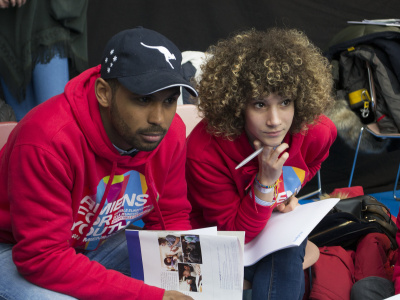
Youth aspiring towards the African dream
Africa has the youngest population in the world, with 60% of the total population in sub-Saharan Africa aged 25 years and below. The growing number of young people is the continent’s greatest asset for growth and achieving its developmental agenda – but only if that generation’s economic development and rights are fulfilled. This was the central message of this year’s African Youth Sustainable Development Goals (SDGs) Summit.
The largest youth summit in sustainable development was not the only high-level event to focus on the potential of youth. Expecting a duplication of Africa’s population from its current 1.4 billion to 2.5 billion by 2050, the sixth EU-AU Summit has laid down commitments to youth development. In particular, focusing on supporting young businesses, enhancing education and training, creating decent jobs and promoting cultural exchanges, among others.
The ambitions are well articulated, but there is much to be done to meet the expectations of the African youth. And although these programmes add to existing youth initiatives at the continental level, concerns arise about whether they speak to the realities of youth on the continent.
Towards an ambitious youth agenda?
Youth in Africa face various challenges further perpetuated by the pandemic. Currently, there is a lack of decent jobs, gender inequality, rising insecurity and unstable political governance due to unconstitutional changes of governments, especially in West African countries. All these factors undermine young people’s individual and collective aspirations.
Further, climate change is causing food scarcity, poverty and an increase in commodity prices, recently amplified by the war in Ukraine. This has led to the instability of young people on the continent, who have resorted to migration, searching for greener pastures elsewhere.
To overcome these challenges, the African Union (AU) and its member states have developed several youth development policies and programmes at the continental level over the last decade. Their commitment toward harnessing youth potential through various inter-continental youth initiatives is anchored in the spirit of the Agenda 2063, the SDG goals and stipulated in the African Youth Charter.
Initiatives included the ASPYEE platform, a knowledge platform for building collaboration among the African youth, the 1 Million by 2021 project, a programme mobilising youth and catalysing actions on youth development, the appointment of the AU Chairperson special youth envoy to champion youth issues at the continental level, and the AU youth volunteer corps, which offers volunteering and exchange programmes within AU institutions to gain experience.
However, AU youth programmes lack the finances to fund their initiatives and they are rather disconnected from the grassroots youthful population. Besides, most of the programmes are too technical in their design. They usually demand strong research skills, excellent writing, and fluency in foreign languages (English or French), benefiting only those who are well-placed and educated with some financial means. Such requirements overlook the largest youth base in Africa, those with low secondary education, who speak local languages and often with vocational practical training.
What can be done differently at the continental level?
In many African countries, governments are not exploiting the potential of their youth yet. Most young Africans have acknowledged that governments are not providing enough support for their socio-economic well-being. Lack of attention towards youth empowerment has been a major factor for the underdeveloped status of most African countries.
The AU seems to recognise this challenge. As reflected in their approach, they have increased the number of young people within the different AU structures who are engaged in using arts, technology and advocacy to advance the continental development agenda. This is a positive development, but not enough.
Crucially important is the need to support the constructive engagements of youth in the public service, governance and other decision-making processes which affect them. This would involve institutionalising and expanding the role of the African Youth Charter Hustlers under the African Youth Division (AYD) to sensitise and link the different AU programmes with grassroots youth initiatives.
Adopting a muti-stakeholders approach, the AU could work to link the different AU youth programmes with other continental youth initiatives within its member states. This can be done by building on programmes such as the Saleema Youth Victorious ambassadors – an initiative aimed at eliminating female genital mutilation by working with grassroots women-led initiatives and promoting inter-generational dialogue within the Regional Economic Community (RECS) youth associations and national youth councils.
Another aspect would be fast-tracking the ambitions of the African Continental Free Trade Area (AfCFTA) agreement to maximise its promises and benefits. Building on the regional market of RECS will expand the growth of Africa’s informal micro, small and medium-sized enterprises. These enterprises are the biggest source of employment and income generation for women and youth. But also, free movement of people across borders – which is one of the long term objectives of the AfCFTA – would allow young people to pursue opportunities in different countries across the continent. Notably, the benefit of the AfCFTA will be made possible if governments exploit the opportunities of human capital.
A partnership of ‘equals’ – What is there for the youth?
The focus on harnessing the potential of youth is one that goes beyond the AU’s own agendas. It’s one of the topics of the Europe and Africa partnership as well. Europe and Africa have a long-standing relationship, despite being historically complicated and unbalanced.
Of late, the Europe Africa partnership – at least at the level of rhetoric – aims towards a partnership of equals. The new EU-AU strategy pointing toward building alliances based on mutual trust and responsibilities is a step in the right direction.
Nonetheless, as a young African who lived on both continents, it’s hard to see what the partnership adds to the lives of young people in both continents as the partnership of ‘equals’ rhetoric tends to remain at the institutional level in Brussels and Addis Ababa. It ought to trickle down to the realities of the young citizens on both continents.
That means better access to the public welfare, living in a peaceful society, having access to opportunities and creating decent jobs, space for political participation and self-determination to stimulate a conducive environment for youth to succeed on equal footing.
The sixth EU-AU Summit at the beginning of the year was an opportunity to build on the Abidjan Youth declaration. The EU announced its Global Gateway investment packages that encompass youth by facilitating sustainable growth and creating of decent jobs by investing in youth-owned businesses, expanding pathways for cultural exchange and migration mobility through scholarships and employment of young graduates and skilled workers.
This would complement existing programmes supported by the EU such as the Youth Plug-In initiative, which puts young people at the centre of the Europe Africa partnership, the AU-EU youth track programmes, which create youth participation and engagement platforms and the AU-EU youth cooperation hub, where prototype ideas are developed and tested.
What next?
With such a large youthful population, Africa’s demographic dividends remain the continent’s greatest assets for growth. The youth are the building block for achieving global goals and the continent’s developmental agendas. However, there’s more to be done by the AU to realise the ambitions within the African Youth Charter. This would involve re-aligning programmes to match the expectations of youth and linking AU programmes with national and local grassroots initiatives.
The emphasis of Africa-Europe cooperation should be on building synergies within AU youth programming, developing initiatives aimed at facilitating economic growth, creating decent jobs, supporting the implementation of the AfCFTA agreement, and most importantly, involving youth in the peacebuilding process. These efforts would instil confidence in the process, build trust in leadership, and aspire the youth toward the African dream.
The views are those of the author and not necessarily those of ECDPM.




